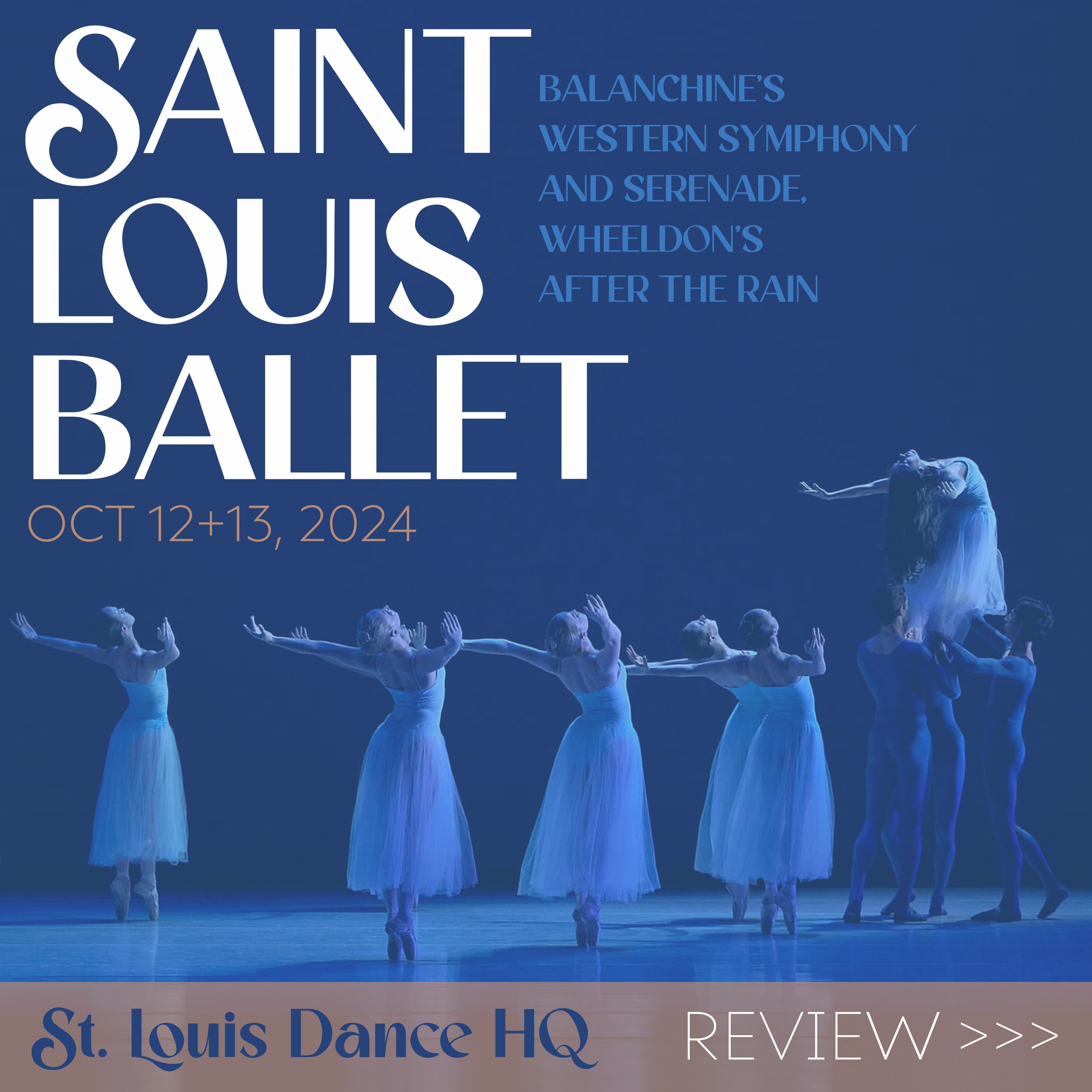HQ Review: Saint Louis Ballet’s “Western Symphony,” “Serenade,” and “After The Rain”
Loose clusters of women stoically stand, arms outstretched diagonally above them. As the romantic swells of Peter Tchaikovsky’s music churn, the dancers’ arms softly ripple through space, and the dance commences with a harmonious simplicity that calls to life the spirit of George Balanchine. This opening tableau came to life when Balanchine first choreographed this work, “Serenade,” in 1934. During the rehearsal process, Balanchine saw the dancers blocking the sun out of their eyes, and he extracted this accidental encounter and utilized it as the opening gesture from which this choreography is born. That is just one of the ways Balanchine expanded how the form of ballet was created. He allowed the process itself to shape a work’s form. In addition, that form did not need anything outside of itself, be it narrative or preconceived context, to evoke emotion. This pioneering work continues to be an evocative piece that brings to life the beginnings of Balanchine’s career in America. It also makes one consider how the legacy of Balanchine continues to have a stronghold upon both the advances and limitations for how ballet exists within America.
The stage pictures that breathe themselves into life in “Serenade” are at once fleeting and profound. The dancers adorned in pale blue tulle skirts act as an extension of their breath as their limbs flick and flutter. The dancers of St. Louis Ballet effortlessly capture the musicality of Balanchine’s work, not merely following the music’s pull, but also weaving another texture of musical complexity within Tchaikovsky’s luscious score. This is particularly evident in soloist Lori Wilson, whose grounded presence on stage feels as though she herself is the conductor and each swell of the music has been internalized in her body. This devout connection to the music is largely reflected by the ensemble, though in the gestures of the opening sequence, feel marginally disconnected. With the stark subtlety of this moment, the impulse of the music is felt slightly differently throughout the ensemble and precisely where those impulses are being initiated within the body. This is a minor drawback though to the overall gravitas that the dancers carry, as they themselves become the extra melody that Tchaikovsky never wrote. This feels most profound in the final image as one woman rises vertically into the air, standing on the shoulders of three men as they slowly walk on the upstage diagonal. Then, with a graceful tension, her torso arches backwards with an internal longing that fills the entire theatre. A longing that is at once heavenly and of this earth.
“After the Rain,” choreographed by Christopher Wheeldon in 2005, is a duet performed by Julia Heiss and Michael Burke, Heiss clothed in a soft pink leotard, and Burke in loose fitting white pants. The melancholic textures of this duet exhibit soft tonalities of strength within both of their physicalities. These textures are then elongated by the wistful melodies of Arvo Pärt’s composition “Spiegel im Spiegel.” There is a stark rawness present on stage. Burke hoists Heiss into the air as her legs elongate behind her. With remarkable dexterity, Heiss arches backwards, her fingers reaching towards the floor as Burke lifts her in a circular pattern whilst Heiss maintains this contorted position. Exhibitions of strength and poise like these are confidently displayed throughout by both dancers. That being said, the relationship to music in this piece carries a noticeably different quality than Balanchine’s previous work, “Serenade.” In Wheeldon’s work, the movements do not add another melody to Pärt’s composition, but rather hum the same tune as the music. While this creates a melodic unison within the piece, it also creates a lack of textural variety that starts to languish by the end. This is especially evident when sandwiched between two Balanchine works that exist within and against the cadence of the musical score so effortlessly. That being said, Heiss and Burke still embody the pensive atmosphere of this work with a corporeal presence that is on its own accord, quite impressive to watch.
The final piece of the concert, “Western Symphony,” choreographed by Balanchine in 1954, is a clear shift from the contemplative tones of the previous works. Vulnerability is traded in for spunk and wit as the dancers of St. Louis Ballet trot and flirt in this romp of a work. With the aesthetics of Western identity, cowboy hats and all, a playful nostalgia for this time period is expounded upon within the balletic form. Balanchine’s choreography takes on elements of American folk dancing as the relationships between the dancers feel much more communal than previously displayed. Dancers on the side of the stage watch as those in center execute thrilling jumps, and smiles lighten up their faces as they connect in playful manners. While elements of traditional ballet vocabulary are utilized throughout, they are heavily imbued with a Western flair. Hands of dancers bounce as if they are holding the reins of a horse. They mime the playing of instruments and they prance across the stage with a carefree spirit. It is not clear as to what has got this group of dancers so wound up in exuberance, but it is of little importance. The vivacity of the movement is enough to fully engage the viewer. The third section captures this vivacity with dashing triumph as Matthew Rusk launches himself through space and Zoe Middleton’s legs athletically unfold from her torso with exceptional ease. Despite the ramifications of Westward expansion, in this work, the choreography delights in it. Though Balanchine was originally from St. Petersburg, he utilizes these themes as a way to ground his work within the context of American culture, further showing that both his ballet technique and his artistic vision exist within a uniquely American context.




